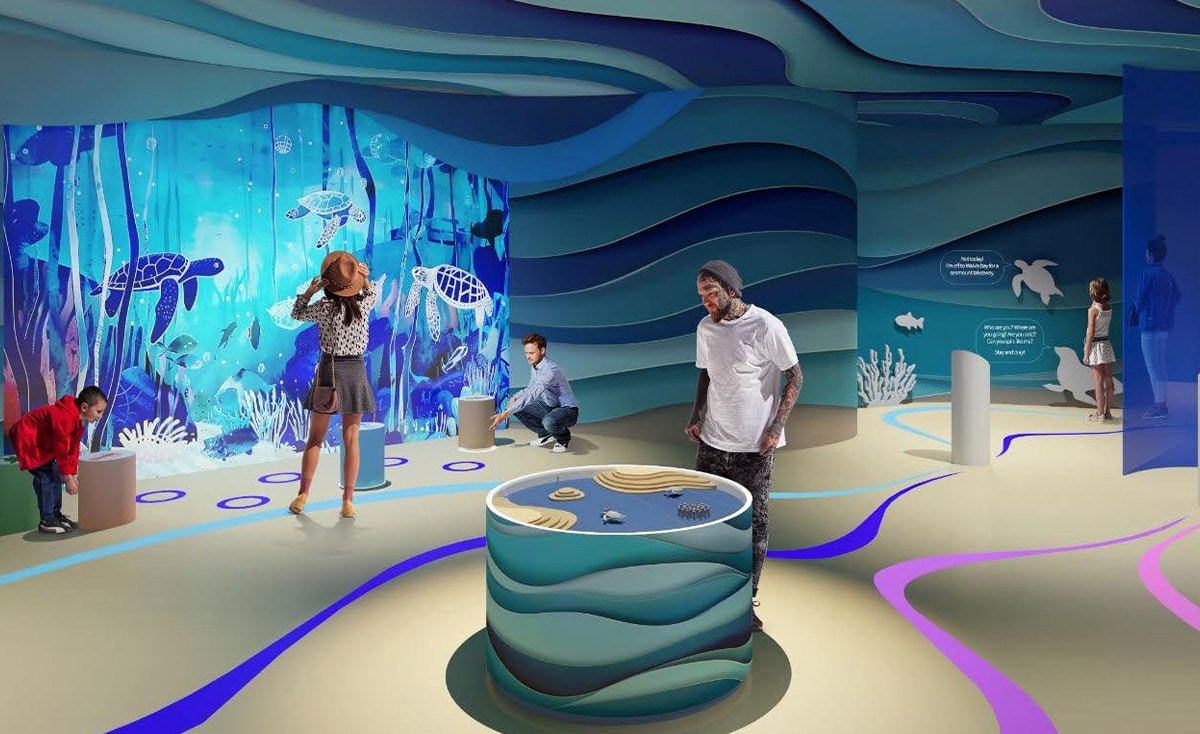
Stepping into a public aquarium can be a magical and memorable experience, especially for those who have not ventured beneath the ocean’s waves. These spaces can serve as vital centres for education and conservation, often inspiring people to care about marine life and even shaping global ocean policy. Yet, it’s not only the marine species that we typically observe in an aquarium that we should care about – we should also place our attention beyond the glass walls where a complex marine world exists. One that is aften not depicted in an aquarium tank. To fully understand our oceans, it is important that citizens also learn about the more remote ocean ecosystems – where foundation species that are fundamental to the food chain exist.
With the high-level 2025 United Nations Conference to Support the Implementation of Sustainable Development Goal 14 (UNOC) having just concluded, formula D_ is calling on the very actors that attended, to enhance science-education through immersive exhibits that depict the importance of remote ocean ecosystems, and foundation species.
Broadening science education with immersive exhibits
To truly connect people with the vast, often unseen, realities of our oceans, science education needs to broaden beyond static aquarium displays. Our work on the
Immersive Gulf Stream Experience at Patricia and Philip Frost Museum of Science, demonstrates the value of this shift, showcasing the incredible potential for depicting remote ocean ecosystems in dynamic, engaging ways.
This exhibit features a large-scale, interactive installation that plunges visitors into the heart of the Gulf Stream. Through 3D visuals and motion-responsive design, it vividly teaches visitors about complex ocean currents and fish behaviours.
What makes this experience truly unique is its interactivity. Using advanced computer algorithms, the exhibit dynamically showcases the ever-changing schooling patterns of thousands of virtual sardines and other marine life. Visitors can directly influence the flow environment in real-time via camera tracking sensors, creating an experience akin to a virtual scuba dive.
As you step into the virtual Gulf Stream projection, you’re enveloped by lifelike three-dimensional animations. This immersive journey introduces you to elusive and seldom-seen creatures that inhabit these vital waters, including species rarely, if ever, seen in a traditional aquarium setting. The Immersive Gulf Stream Experience offers an unforgettable, visceral encounter with this crucial ocean current and its diverse marine inhabitants.
So why the focus on foundation species?
Did you know that the very air we breathe is profoundly linked to the ocean’s tiniest inhabitants? At the absolute base of marine life are phytoplankton – microscopic plants that float in the plankton. Not only do they play a fundamental role in the ocean food web, but also in the global carbon cycle, absorbing carbon dioxide on a scale similar to all the world’s forests and significantly impacting global temperatures. This is turn helps to stabilize marine ecosystems from fluctuating temperatures.
Sardines connect this microscopic world to the broader oceanic ecosystem. These silvery fish are known as “forage species,” transferring energy up the food chain as a food source for larger marine fish, seabirds and mammals.
The important role of aquariums
Public aquariums are essential institutions for marine conservation, rehabilitation, captive breeding and public education. These establishments offer unique opportunities for direct engagement with marine life, fostering a deeper understanding and appreciation of ocean biodiversity. Beyond their captivating displays, many aquariums run critical rescue and rehabilitation programs for injured or sick marine animals, providing a vital lifeline for vulnerable species. They also play a crucial role in scientific research, breeding programs for endangered species, and educating millions of visitors annually on pressing marine environmental issues
Our involvement with the Two Oceans Aquarium’s Turtle Conservation Centre in Cape Town – South Africa, perfectly illustrates this vital function. Here, a dedicated team rehabilitates sea turtles that have suffered severe injuries or wash ashore due to a sickness. Working alongside their incredible rehabilitation efforts, we designed a meticulously structured visitor journey, moving people from initial awareness to deep empathy, and ultimately to active participation. Through immersive storytelling, interactive exhibits, and direct observation of rescued turtles in recovery, the centre cultivates a powerful, visceral connection to the challenges marine wildlife face and the broader threats to ocean ecosystems. A key feature of the experience is a participatory pledge wall, supported by digital content and social media integration, where visitors can publicly commit to ocean-friendly behaviours. Further educational interactives and media installations allow for deeper learning on critical marine threats like plastic pollution and climate change, all tailored for different age groups and learning styles.
Humanity’s impact on marine ecosystems
The human footprint weighs heavily on marine ecosystems. Overfishing and harmful fishing practices rapidly deplete fish stocks and damage habitats like coral reefs and seagrass beds. When species like sardine decline, the resulting disruption affects predators and sets off ecosystem-wide consequences.
Climate change and ocean acidification further exacerbate the problem. Oceans have absorbed more than 90% of the excess heat generated by human activity, which has raised temperatures and altering nutrient cycles. In the Indian Ocean, for example, rapid warming has led to a 20% decline in phytoplankton over the past 60 years, threatening to turn once-productive regions into ecological deserts.
Restoring Balance Through Collective Effort
Despite these challenges, solutions exist. Habitat restoration, including wetland reconnection, coral and shellfish reef repair, boosts biodiversity and stimulates economic activity. Nature-Based Solutions (NbS) offer integrated approaches to climate mitigation and biodiversity conservation. Initiatives like mangrove planting, seagrass restoration, and kelp forest rehabilitation improve ocean health while supporting fishing communities.
On a personal level, reducing pollution, choosing sustainable products, supporting ethical fisheries, and participating in beach clean-ups contribute meaningfully.
Addressing illegal fishing practices and implementing sustainable fishery policies are also critical steps forward.
Our Call to Action following the UN Ocean Conference
Understanding the vital roles of foundation and forage species like phytoplankton and sardines is essential for safeguarding marine ecosystems. The UN Ocean Conference provided a crucial platform to broaden ocean conservation. While many countries pledged for improved ocean governance, increased MPAs, and reducing marine litter; there was very little conversation around ocean literacy and science education. If we want to shift the concerning trends on marine litter and overexploitation, we need to shift the mindsets and millions of citizens. This starts with effective science communication that inspires people to act differently, make better decisions and possibly even pursue a career in ocean conservation.



